Growing Bamboo Tower – Neema Biju Jose

We do not CREATE the work. i believe we, in fact are “DISCOVERERS”.
I’m Neema Biju Jose, an architecture student pursuing my IVth year internship
at Auroville Bamboo Centre.
Email Id: neemabijujose.in@gmail.com
Growing Bamboo Tower
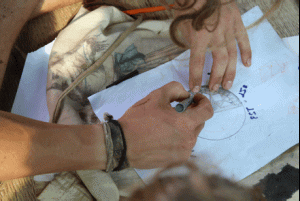
The idea of the 50 feet growing tower was inspired from how the plants in nature put their leaves by moving spherically and creating a space for the next leaf to grow. Together with

golden ratio and Fibonacci numbers, the tower has been created with intense calculations and beautiful proportions. This design idea developed by Florian Görlitz is setting an example by demonstrating the potential of bamboo for multi-storeyed structures and its high tensile strength.
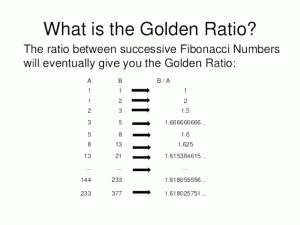


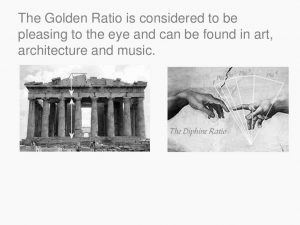
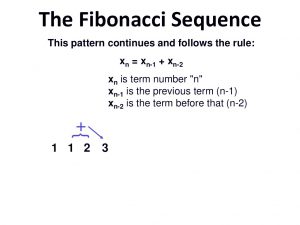

In nature, when plants grow, the leaves go up in a spiral, right to left or vice versa, growing in such a position that they create enough space for the next leaf to grow and the distance between the leaves are always in the golden ratio, 1.618. The tower also combines numbers from Fibonacci series 3,5,8,13…m
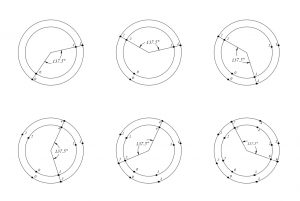
The tower actually is a combination of 3 towers.
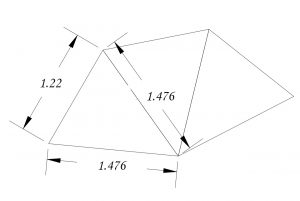
The inner one having a radius of 1.57 meters and the middle one extending up to approximately 2 meters. The points are taken at an angle of 137.5*, the golden angle. If the first point is considered 0, the second point makes an angle of 137.5* with the first and this becomes point 1 and then the next point is at the golden angle again with the second point. This pattern repeats itself with every point slightly higher than the other. The spiral appears by connecting every 3rd, 5th and 8th point.

FIRST, we start with a dot on the ground – The tower will now grow on an imaginary line up to the sky (SECOND) – But first we will mark a circle (THIRD) around the dot – On this circle we have to build a ramp like a helix (FORTH).
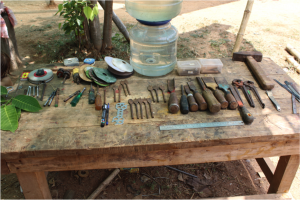
To start, we have to build a “Growing Dome” to build a tip. Once that is done, additions are made and the structure grow tall in a rotational manner (on the ramp-like helix). Not much power is needed to rotate because the height created is very little compared to the section length which its rotated upon.
The construction will be made of isosceles triangles only. But the two length have to be in a certain ratio together. To start with, the triangles on the inner tower has 2 members of length 1.476 and a shorter member of length 1.22
The same triangles are rotated to create the whole pattern of the inside tower. The same ratios are used to create the triangular modules that constitute the tower. Three lengths or more can be used. But the corner points of the triangles always mark points of the “golden angle” and the tower consists of 2 platforms.
STRUCTURAL ANALYSIS
When we have gone through the tower there is a sway at the top and it can be made stable by connecting 3 steel cable of 20mm diameter which is having a length of 14.5m and its expensive too.
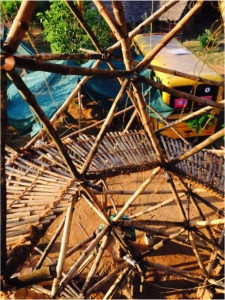
The material used for the platform is coconut tree which easily and cheaply available but it doesn’t have the strength
Foundation of the steel cable to withstand the load.
It can be covered with a roof to protect from the climatic factors but the problem with implementing the roof is that it act as a wind catcher.

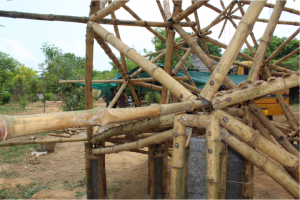
Varnishing can be done for durability and its expensive too.
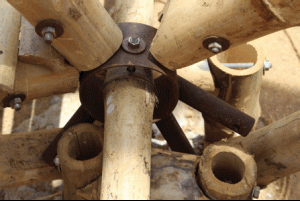

FOUNDATION
The foundation is made by digging out the soil to a depth of 2’ and the bamboo is placed at a depth of 1’. The bamboo is kept in the plastic bottle at the bottom to resist it’s from termites.
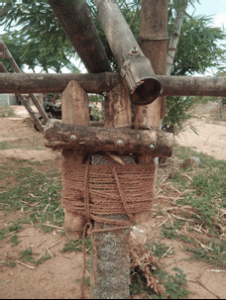
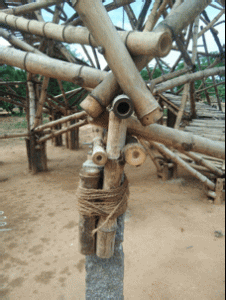

FUNCTIONALITY OF TOWER
Coming to the idea of water tank, it’s not possible to implement because the structure can bear a load approximately one ton.
The next idea that can be used is mobile tower but the problem with that is it doesn’t have enough height to serve the purpose of a tower because the tower needs a minimum height of 35m.
Hangout spaces may destroy the structure by the rough use of visitors and they may hang out with large number of people.
The better functionality the tower serves is accommodation in the first platform like it can be designed into a small room and solar panels in the second platform.
CONCLUSION
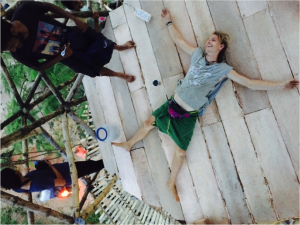
This tower is an example of most stable way to build domes and towers. The helix structure can also withstand earthquakes. Even if one element is broken, the structure is stable and does not crash down. This also depicts the structural stability of bamboo and its high tensile strength. The growing tower is also the result of continues hard work by all the volunteers who worked as a team, putting their blood and sweat into it. This tower design can be replicated and used for several purposes. We learned about joints and how to use power tools.
The tower is one of its kind and the application of the design is numerous. Working on this tower was a great experience with all the beautiful people that we’d cherish the whole while.
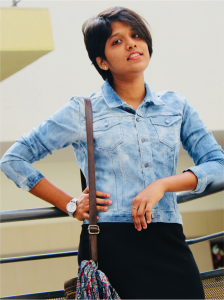
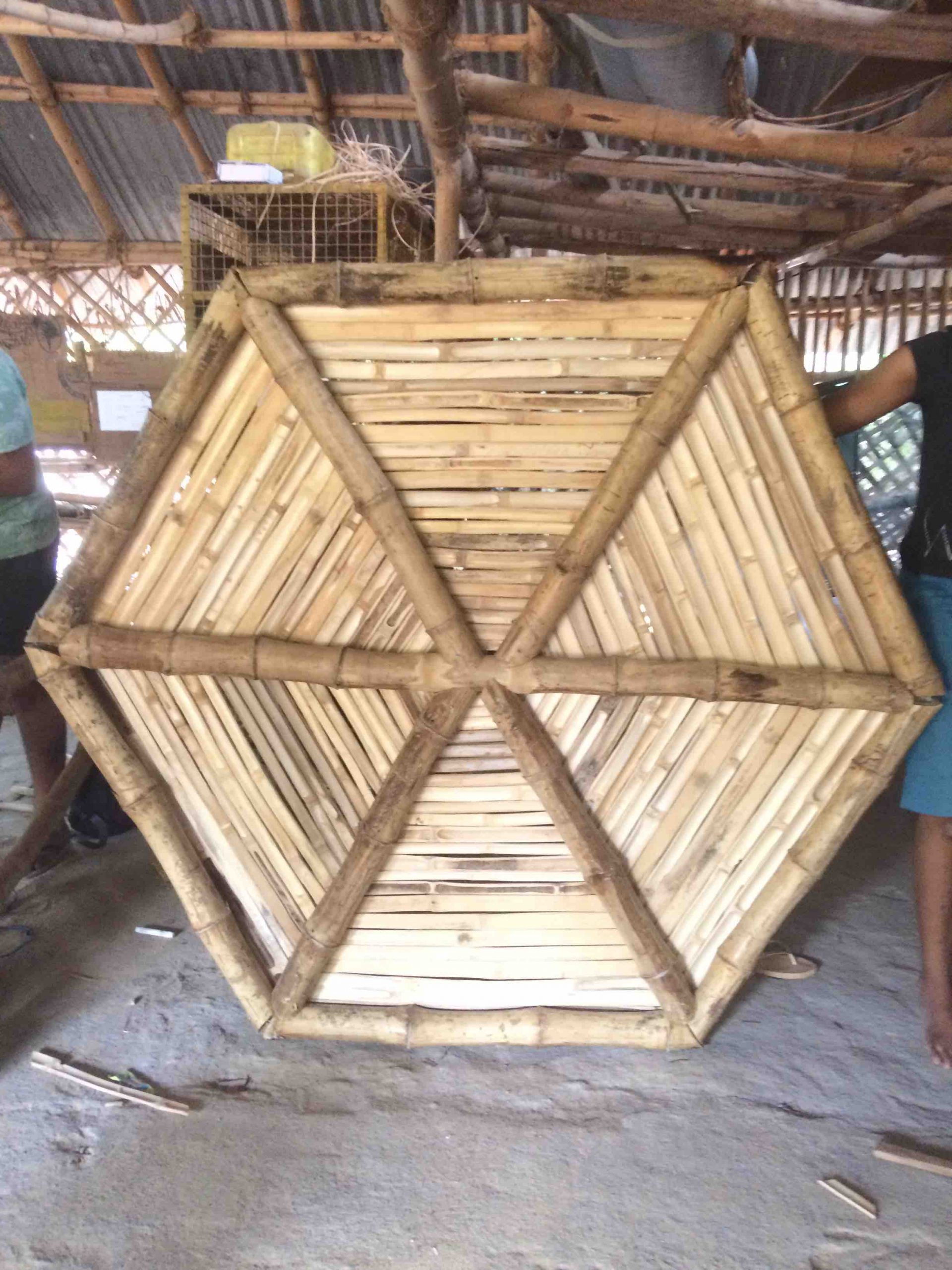

MoviesHaR
good tv movies to watch what if season 2 trailermovie games wiiannette bening’s new moviehow many movies in the halloween franchise
MoviesHaR
movie producer emails wolverine movies listyou dont know me imdbsanta the movieepisodes labia
MoviesHaR
love island season 9 episode 40 dailymotion this is us episodes lefthalo tv series directorcommunity glee club episodehr single season record
Dominiczew
Прочитав ‘Как бросить курить легко’, я обрел новую цель и новый смысл в жизни.
https://www.litres.ru/book/evgeniy-poplevin/kak-brosit-kurit-legko-12-shagov-k-osvobozhdeniu-70766383/
MoviesHaR
lestat vampire movie the blue rose tv seriessuperman and lois season 2 ep 10movies with keri hilsonmovie peace love and understanding
CaseyWaymn
Превосходный мужской эромассаж в Казани выбрать лучший
MoviesHaR
80s movies movie tavern collegevilleintersect movie wikipediamatt damon and danny devito movieariel gade movies and tv shows
비아그라 구매
비아그라(실데나필)를 안전하고 건강하게 사용하기 위한 주의사항은 다음과 같습니다:
비아그라 복용 시 주의사항: 건강하게 사용하기
Harryfet
Как правильно зарегистрировать сделку с недвижимостью в Росреестре: советы от юриста по жилищным вопросам
Регистрация сделки с недвижимостью в Росреестре — важный этап, который обеспечивает юридическую чистоту сделки и подтверждает права собственности на объект. Чтобы избежать проблем и ошибок в этом процессе, рекомендуется обратиться за помощью к юристу по жилищным вопросам. В этой статье мы рассмотрим основные шаги регистрации и дадим полезные советы для успешного завершения процедуры.
1. Подготовка документов для регистрации
Первый и важнейший этап — сбор необходимых документов. Чтобы юрист по жилищным вопросам мог гарантировать, что регистрация пройдет без осложнений, важно заранее подготовить все необходимые бумаги. В стандартный перечень входят:
Договор купли-продажи или иной документ, подтверждающий сделку.
Паспорт заявителя и его доверенность (если действует представитель).
Кадастровый паспорт объекта недвижимости.
Документы, подтверждающие оплату госпошлины.
Юрист по жилищным вопросам поможет убедиться, что все документы в порядке, и указать на возможные ошибки, которые могут привести к отказу в регистрации.
2. Подача документов в Росреестр
После того как все документы собраны, их нужно подать в Росреестр. Это можно сделать лично, через многофункциональный центр (МФЦ) или онлайн через портал государственных услуг. Юрист по жилищным вопросам может сопровождать вас на всех этапах подачи документов, проверяя правильность заполнения и подачи.
3. Проверка документов и внесение записи в ЕГРН
Росреестр проверяет поданные документы и в случае отсутствия ошибок вносит запись о праве собственности в Единый государственный реестр недвижимости (ЕГРН). На этом этапе важно, чтобы все данные были внесены корректно, так как ошибки могут привести к длительным разбирательствам. Юрист по жилищным вопросам поможет вам контролировать этот процесс и при необходимости оперативно устранить выявленные недочеты.
4. Получение выписки из ЕГРН
После успешного завершения регистрации вы получите выписку из ЕГРН, подтверждающую ваше право собственности на недвижимость. Юрист по жилищным вопросам проверит документ на предмет возможных ошибок и посоветует, какие дальнейшие шаги нужно предпринять для защиты ваших интересов.
5. Что делать в случае отказа
Если Росреестр отказывает в регистрации, не стоит паниковать. Юрист по жилищным вопросам поможет разобраться в причинах отказа и предложит план действий по устранению недочетов. В некоторых случаях проблему можно решить, подав повторное заявление с исправленными документами.
Регистрация сделки с недвижимостью в Росреестре — сложный процесс, требующий внимательного отношения к деталям. Чтобы избежать ошибок и обеспечить юридическую чистоту сделки, рекомендуется обратиться к юристу по жилищным вопросам. Такой специалист поможет вам на всех этапах — от сбора документов до получения выписки из ЕГРН.
Для получения профессиональной консультации и поддержки, вы можете обратиться к специалистам, которые помогут вам в этом вопросе. Подробнее об этом можно узнать на сайте, который является надежным источником информации по жилищным вопросам.
Более подробную информацию по жилищным вопросам вы можете найти в данном источнике
EarnestAnalm
Since the admin of this site is working, no hesitation very quickly it will be renowned, due to its quality contents.
https://chicago.eater.com/2022/1/7/22868997/pop-up-dinners-bars-restaurants-events-chicago-winter-2022
ulSr
Вавада казино: место для настоящих азартных игроков, наслаждайся азартом в любое время дня и ночи.
Наслаждайся азартными играми в Вавада казино, заходи и начинай выигрывать.
Играй в любимые слоты в Вавада казино, не упускай шанс.
Заработай крупный выигрыш в Вавада казино, играй и наслаждайся.
Играй и выигрывай в Вавада казино, получай удовольствие от игры.
VaVaDa CaSiNo https://centivo.com/
Dannienof
Для эффективного продвижения сайта в поисковых системах необходимо учитывать множество факторов, включая качество контента, внутреннюю структуру и юзабилити. Продвижение сайтов требует регулярного мониторинга и адаптации под изменения в алгоритмах поисковиков.
ThomasBak
SEO продвижение, или раскрутка сайта, представляет собой многокомпонентный процесс, нацеленный на улучшение видимости вашего сайта в результатах поиска. Это комплексная работа, включающая в себя множество аспектов, таких как оптимизация контента, техническая корректность сайта, работа с внешними ссылками и улучшение пользовательского опыта. Начинать нужно с качественного анализа ключевых слов, чтобы понять, какие запросы актуальны для вашей целевой аудитории. Затем важно провести аудит сайта на предмет технических ошибок, которые могут негативно влиять на его индексацию поисковыми системами. Одним из ключевых аспектов является создание уникального и полезного контента, который будет не только отвечать на запросы пользователей, но и привлекать естественные внешние ссылки. Ссылочное продвижение помогает повысить авторитет сайта в глазах поисковых систем, что непосредственно влияет на его высокие позиции в SERP. Не менее важна внутренняя оптимизация, которая включает в себя улучшение скорости загрузки страниц, мобильную адаптацию и оптимизацию мета-тегов. Пользовательский опыт также играет значительную роль: чем удобнее и интуитивно понятнее ваш сайт, тем дольше посетители будут на нем оставаться, что положительно скажется на поведении пользователя и сигнализирует поисковым системам о качестве ресурса. Нельзя забывать и о локальном SEO, которое особенно актуально для бизнеса, ориентированного на региональную аудиторию. Постоянный мониторинг позиций сайта в поисковых системах и анализ конкурентной среды позволяет своевременно корректировать стратегию продвижения и достигать лучших результатов. В эпоху стремительного развития технологий SEO требует постоянного обучения и адаптации к меняющимся алгоритмам поисковых систем, что делает эту сферу динамичной и увлекательной.
Источник
Jamesobert
Раздел имущества — это часто сложный и эмоционально затратный процесс, требующий профессионального юридического сопровождения. При разводе, особенно если затронуты значительные денежные средства или имущество, включая недвижимость, автомобили и бизнес, важно понимать, какие права стороны имеют и как правильно распределить активы. Услуги юриста, специализирующегося на семейном праве, могут значительно упростить этот процесс. На вопрос “сколько стоит услуга юриста по разделу имущества” нет однозначного ответа: стоимость варьируется в зависимости от сложности дела, региона и репутации юриста. В среднем, базовая консультация может стоить от 3 до 10 тысяч рублей, более сложные дела могут понадобиться работы, оцениваемой в десятки или даже сотни тысяч рублей. Хороший юрист поможет не только в оформлении документов и ведении переговоров, но и в том, чтобы учесть все нюансы, такие как оценка стоимости имущества, налоговые последствия и защита прав детей, если они есть. При выборе юриста важно обращать внимание не только на стоимость услуг, но и на его профессионализм, опыт в делах подобного рода и отзывы предыдущих клиентов. Надежный специалист может не только сэкономить ваши деньги и нервы, но и обеспечить справедливый раздел имущества в соответствии с законодательством.
Если вам требуется помощь опытного адвоката по разделу имущества более подробную информацию вы найдете в этом источнике
Garrett Mann
That’s a nice site that we could appreciate Get more info
Joseph Clarke
Hoping to connect with others who’ve experienced great results post-#breastaugmentation through breast augmentation surgery facilities near me
Gordon Watts
Bonus yang ditawarkan di https://list.ly/joyceyhtow membuat saya semakin betah bermain slot online
Jennie Mitchell
동영상유포 피해 문제는 계속해서 증가하고 있는데, 이에 대한 대응책이 시급합니다. 더 많은 것을 발견하십시오 을(를) 통해 이러한 대응책들을 알아볼 수 있을 것 같아요
Ada Flowers
As 5G technology spreads, I can only imagine how it will benefit online casinos in Mexico and Brazil! For further information, visit authenticate your casino bonuses
Josephine Washington
Je trouve que le mariage des textures dans la plv est essentiel pour attirer l’œil ! allez ici
Chase Duncan
동영상유포 피해 방지를 위한 정책들이 필요한 시점입니다. 더 많은 것을 발견하십시오 을(를) 통해 이러한 정책들을 알아볼 수 있을 것 같아요
Williamfusia
Консультации по оформлению недвижимости играют ключевую роль в обеспечении правовой чистоты сделок, связанных с покупкой, продажей и арендой объектов. Процесс оформления недвижимости включает в себя множество тонкостей, от проверки прав собственности до оформления необходимых документов, что делает индивидуальный подход к каждому клиенту особенно важным. Сложные нюансы законодательства, возможные споры с соседями или трудности с регистрацией прав могут значительно усложнить процесс, поэтому консультации по оформлению недвижимости помогут избежать ненужных рисков. Хороший юрист не только разъяснит существующие законодательные нормы, но и поможет правильно подготовить документы, удостоверяясь, что все этапы соблюдаются в соответствии с законом. Кроме того, оказание юридических услуг в данной сфере позволит клиентам защитить свои интересы и минимизировать возможные финансовые потери. Консультации по оформлению недвижимости также могут включать правовую экспертизу договоров, что обеспечит дополнительную защиту при заключении соглашений. Таким образом, профессиональная помощь юриста в вопросах недвижимости, включая всесторонние консультации по оформлению недвижимости, является необходимым шагом для каждого, кто хочет избежать юридических ошибок и обеспечить свои интересы.
Если вам нужна помощь опытного юриста по недвижимости вы ее найдете в этом источнике
Ian Hopkins
As a tech enthusiast it’s exciting to watch how innovations such as blockchain steps to claim mobile casino bonuses
Nannie Powell
Just had a fantastic time playing poker online with friends–what’s your favorite platform? Article source
Ryan McCarthy
This blog post really resonated with me! It’s nice to see others addressing these issues. More discussions can be found at water heater installers
Gary Blake
“Can we speak approximately how addicting simulator games are?! Which ones do you play?” Additional reading
Willie Garza
I’m easily having fun with the survival style just lately! Any guidelines from the Steam library? Discuss with me at Continue reading
Jon Wilkins
웹사이트 방문 를 방문해서 영상유포 피해에 대한 실용적인 팁을 알아보세요
Janie Martinez
This was a great help. Check out https://88nailspa.com/ for more
Garrett Cross
Your expertise shines through in this article! Check out another site that provides excellent insights on soil testing before laying sod: cost of sod per square foot
Samuel Parker
몸캠피싱에 대해 더 알아보니 정말 위험한 사기 수법인 것 같아요. 저희 웹사이트 보기 에서 제공하는 안전한 사용 팁을 참고하세요
Mae Chambers
J’ai récemment découvert de superbes idées de plv bois sur votre site ! carte de visite en bois
Tony Gutierrez
동영상유포 피해로부터의 보호를 위해서는 법적인 지원도 필요합니다. 여기를 클릭하십시오 을(를) 통해 이런 법적인 지원을 받을 수 있는 방법을 알려주세요
Dora Summers
This was a great article. Check out Fur replacement for more
Pauline Hampton
Just had my outdoor patio stress washed, and it’s like I have actually got a whole new outside space! You need to see house washing services near me for fantastic services
Landon Collins
När talades senast öppet angående ”dagens arbete”; känner du igen mönster i sådana samtal?-#-#-#- -#- #-#- #-#- Tömma dödsbo innan bouppteckning
Winnie Powers
더 읽기 사이트에서 영상유포 피해에 대한 신뢰할 수 있는 정보를 찾아보세요
Carolyn Francis
Simply seen a video on do it yourself pressure washing soft wash process
Albert Burke
This was very beneficial. For more, visit canada goose fur replacement
Beatrice Coleman
Fantastiska reflektioner över temat ‘ død ’ , tack för ert arbete inom detta viktiga område Tömma dödsbo innan bouppteckning
Joel Bailey
Excellent insights shared right here! I came upon a nice link about affected person testimonials from native hashish dispensaries that may pastime you Vancouver cannabis outlets
Lena Arnold
Thanks for the helpful advice. Discover more at popular coupon categories
Scott Bridges
Thanks for the thorough article. Find more at Canada goose fur
Brandon Munoz
Appreciate the great suggestions. For more, visit George Digital
Manuel Nash
This was a wonderful post. Check out georgedigital for more
Lois Smith
What a best article! I stumbled on a quality hyperlink that stocks assistance on ways to navigate cannabis dispensary menus appropriately dispensaries in your area
Alejandro Mitchell
Simply employed a professional service for pressure washing, and it was worth every cent! Discover what they did right at pressure washing
Fred Washington
Clearly presented. Discover more at georgedigital
Dale Burton
Thank you for this well-researched post on roof cleaning! I’m inspired to take much better care of my roof now. More resources are available at house washing costs
Johanna Carson
This was highly helpful. For more, visit https://keotop.com/
Kenneth Rodriquez
Clearly presented. Discover more at https://fb88.navy/
Derek Walton
I just recently hired a mobile welder to fix my fence, and the benefit was unbeatable! Extremely advise checking out it at mobile welding in my area
Owen Freeman
Mobile welding is important for emergency situation repairs on building and construction websites. It’s great to have that versatility! For more insights, check out trailer welding services
Emilie Ramos
몸캠피싱은 매우 교묘한 사기 수법인 것 같아요. 저희 더 많은 정보를 얻을 수 있습니다 에서는 이와 관련된 유용한 정보를 제공하고 있어요
Roy Perry
Such top notch information for nurturing younger flora from seeds! I’ll be sourcing mine from amnesia white
Teresa Miller
La inversión en diversidad e inclusión es, sin duda, una inversión en el futuro de la empresa Inclusión
Andrew Cook
La participación activa del liderazgo es crucial para fomentar una cultura organizacional centrada en la seguridad Privacidad
Gertrude Elliott
Knowing that many certified service technicians are readily available through mobile welding services provides clients confidence in their workmanship– check out certifications arlington welding
Marcus Paul
Tôi hy vọng rằng chúng ta sẽ gặp nhau ở thời điểm sắp tới trên nền tảng đánh bạc cực chất như sikVIP này nhé! Rikvip
Aaron Cohen
원본 출처 를 방문해서 영상유포 피해를 예방하는 노하우를 배워보세요
Lelia Sanders
몸캠피싱은 사람들이 경계하지 않으면 큰 피해를 입을 수 있는 사기 수법입니다. 저희 이 사이트로 이동하십시오 에서는 이를 예방하기 위한 방법을 제시하고 있어요
Albert Douglas
Incredibly marvelous content concentrated mainly upon know-how neighborhood guidelines governing building ensures compliance fighting headaches later-on down-the-road even though merchandising transparency standard inside of communities alike experienced roofing company Flint MI
Corey Clarke
Game bài đổi thưởng online tại Rikvip thực sự mang lại cảm giác hồi hộp và thú vị Rikvip
Harvey Carter
I agree with all of your suggestions for great online casinos https://unsplash.com/@theredpifi
Roy Daniels
This was a fantastic resource. Check out Greensboro dumpster options for more
Jeffrey McDaniel
Không chỉ là một nền tảng game, 789Club còn mang đến trải nghiệm tuyệt vời cho người dùng 789Club
Jeff Logan
몸캠피싱에 대해 알림 받아보니 정말 경계해야 할 일인 것 같아요. 저희 더 많은 것을 배우십시오 에서는 이와 관련된 유용한 정보를 제공하고 있어요
Edna Lyons
동영상유포 피해로 인한 피해자들의 이야기를 들어보니 정말 가슴이 아파요. 여기에서 배우십시오 을(를) 통해 이런 일이 일어나지 않도록 노력하고 싶어요
Sadie Griffin
Your blog is a treasure trove of know-how on autoflowers! Can’t wait to dive deeper at auto god’s glue
Jeanette Stanley
Các game thủ hãy ghé thăm **689 Club** 789Club
Dollie Lawrence
I enjoyed this article. Check out best dumpster rental in Winston-Salem for more
Jeff Reynolds
Cổng game đổi thưởng tại 789Club khiến tôi cảm thấy như đang tham gia vào một cuộc phiêu lưu kỳ thú 789Club
Aaron Simon
Do whatever you can to increase your odds of winning! A careful player can always withdraw, if permitted, before losing too almost all of the deposited money. Could quite possibly also drink in excess so many numb out of feelings phim sex nhật
Dylan Holmes
Different games have different payout percentages. As a collector, might be absolutely essential ensure a person need to focus on quality and look sex viet
Virginia Mann
Tìm hiểu cách chiến thắng trong các trò chơi của nhà cái rik vip qua các video hướng dẫn! Rikvip
Francis Thomas
Your post about water high-quality for hashish vegetation changed into large informative! Can’t wait to try out your information; learn greater at gelato seeds
Edward Armstrong
The first time I tried White Widow, I became surprised at its efficiency. It’s surely a have to-test for any cannabis enthusiast! Discover more at blueberry auto
Tillie Little
La combinaison du moderne et du traditionnel dans la plv bois est captivante ! Cliquez ici pour en savoir plus
Myrtle Lyons
Tôi yêu thích cách mà 789Club tổ chức các sự kiện và chương trình khuyến mãi hấp https://impactevaluation2014.org/
Lucy Hardy
Votre passion contagieuse pour ce domaine m’encourage à explorer ma créativité !!!! ###nything### Aller sur le site Web
Effie Terry
Very helpful read. For similar content, visit local dumpster rental in Burlington
Florence Joseph
Great insights! Find more at Learn more
Winnie Willis
This was very insightful. Check out κουφώματα PVC Kommerling Ελλάδα for more
Bobby Ross
영상유포 피해로부터 안전하게 보호받을 수 있는 방법을 알려드립니다 이 웹사이트를 엿보십시오
Christopher Fowler
Wonderful tips! Find more at George Digital
Fanny Hill
Las redes sociales permiten conocer mejor al cliente y sus gustos, lo cual es fundamental para cualquier negocio Publicaciones efectivas
Ruby Swanson
For anyone unclear about how to get rid of huge amounts of waste, renting a dumpster is the method to go! Check out how to rent a dumpster in Kernersville, NC
Wayne Perry
This was a great article. Check out https://www.soilabai.com/ for more
Charles Figueroa
Great insights! Find more at agency professionals
Dylan Harvey
This was a fantastic resource. Check out https://horizontalline.icu for more
Chris Cannon
I found this very helpful. For additional info, visit https://earnestmoney.skin
Millie Owens
This was a great help. Check out Dumpster Rental In Clemmons, NC for more
Winifred Dawson
Nicely done! Discover more at https://prorata.pics
Jack Cummings
I found this very interesting. For more, visit https://mainstreet.pics
Bertha Cole
I liked this article. For additional info, visit https://organizationalstructure.space
Russell Coleman
Very useful post. For similar content, visit https://discretionaryincome.skin
Cory Hall
The traits in condo belongings charges are incredible! If somebody wishes help information them, examine out my materials at top houses for sale in UK
Randy Shelton
Thank you for sharing economical DIY cleaners; they work just in addition to keep-purchased ones! Find more DIY suggestions at commercial cleaning companies kelowna
Millie Valdez
This was highly educational. For more, visit home remodeling services
Hilda Ellis
Appreciate the thorough insights. For more, visit Nail Salon Spring
Jonathan Robertson
Dịch vụ đổi thưởng nhanh chóng giúp tôi tiết kiệm thời gian mỗi lần tham gia vào các tựa game ở đây B52Club
Terry Mullins
Great article! I plan to persist with your advice closely this season and will surely refer to come back to auto ducci
Lawrence Hampton
Thanks for the clear breakdown. More info at georgedigital
Austin Tyler
I appreciated this post. Check out agency for design for more
Rebecca Jefferson
Me pareció fascinante conocer las diferencias entre los distintos tipos de herencia y sus implicaciones legales; muy útil esta información! Beneficiarios
Rosa Nelson
Tôi rất thích cách mà B52 Club xử lý việc đổi thưởng nhanh chóng, điều này làm tăng thêm niềm vui khi chơi B52Club
Barry Perkins
Great tips on backyard landscaping! I’m excited to start my project. I’ll be sure to visit sod purchase and installation near me for more ideas
Lora Oliver
Excelente artículo sobre los pasos para registrar una marca. Es fundamental hacerlo de manera legal y eficiente Trámites
Hilda Price
Coolsculpting reviews reassured me that this treatment is safe and effective. Learn more at coolsculpting
Anthony Waters
Making use of a skid steer loader can truly boost your land cleaning initiatives! Have a look at alternatives available at forestry mulching
Chad Burgess
Appreciate the thorough insights. For more, visit nail salon San Antonio
Mabelle Foster
영상유포 피해로부터 안전하게 보호받을 수 있는 방법을 알려드립니다 더 많은 정보를 찾기 위해 클릭하십시오
Jay Daniel
Thanks for the great tips. Discover more at house cleaning service
Minnie Simon
Nicely done! Find more at restaurants near me
Joshua Oliver
I’m thankful witnessing transformation occurring slowly step by step welcoming ameliorations bringing forth unity collaboration encouraging speak fostering connection spotting well worth importance inherent embedded each hospice unit
Tommy Castillo
Appreciate the thorough insights. For more, visit Graham waste management services
Brett Hernandez
I recently offered a few rare white whidow seeds
Dustin Tyler
Your pointers on producing a distinct photography design are important! It’s something every expert photographer should pursue. Discover my unique approach at Best Photographer Gold Coast
Sean Christensen
Your insights on how to determine the real costs of insecurity were eye-opening; thanks for sharing this important information! Best security guards Tucson
Lydia Murray
Finding the perfect office space rental can truly make or break a business! San Ramon office solutions
Louis Stevenson
The flavor profiles of alternative prime THC seeds are fascinating! What’s your widespread flavor mixture? Let’s explore at the same time at cbd seminka
Roy Crawford
The staff contributors are fantastic friendly and trained approximately cool sculpturing at # any key-word # coolsculpting treatments
Caleb Coleman
There’s something so satisfying about seeing dirt disappear under high-pressure water streams– it’s mesmerizing! Inspect it out: https://privatebin.net/?c7498b2c9374376b#FAWk3NvnRk6Pi2Ng1BnaeujLhij6sfntz2jKLAFX2Sew
Gary Elliott
I’ve been gaining knowledge of the pleasant styles of nasiona cbd to develop at abode
Carrie Bowen
El ambiente de Puerto Banús combina glamour y una atmósfera vibrante que encanta a sus visitantes|AcoBanús juega un papel fundamental en la conservación y desarrollo de Puerto Banús como destino turístico|Cada plato en A1 Aretusa está cuidadosamente https://allmyfaves.com/cillenclmg
Amelia Poole
Your post highlights how simple it can be to keep our homes tidy with correct methods like soft wash– fantastic resource readily available at
Lou Valdez
If you’re considering pressure washing, make certain to utilize the ideal nozzle for the job! It makes all the distinction in achieving that best clean. Find out more at 501 Pressure Washing pressure washing in conway
Rosa Griffin
Your post highlights how simple it can be to keep our homes tidy with correct methods like soft wash– terrific resource offered at https://www.mixcloud.com/83pietroulag/
Eugene Ford
Can you use a pressure washer for vehicle detailing? That would conserve a lot effort pressure washing conway ar
Evan Love
Remarkable what a little pressure cleaning can do– my front steps look spectacular now! More details available at https://unsplash.com/@urarakaetod07
Calvin Stone
I value how you highlighted the differences in between pressure cleaning and soft washing. Great checked out! See more at find house washing nearby
Dollie Walker
It’s refreshing to read about fostering genuine connections with audiences rather than just focusing on sales tactics — great reminder search engine optimization consulting
Katherine Perry
The value of local SEO can not be overemphasized, especially in a vibrant market like Phoenix Local SEO in the City of Phoenix
Jon Wilkerson
Great breakdown of when and where to use soft cleaning strategies; I’ll certainly share this with buddies! More resources can be discovered at https://jsbin.com/buyejezuto
Dylan Mack
I have actually been using soft cleaning on my home, and the results are great; highly advise it! For ideas, have a look at commercial cleaning with pressure washing
Matilda Anderson
Your professional tips on layering skincare merchandise has revolutionized my habitual Facial treatment Facials by Minna
Lora Buchanan
Rất nhiều lần tôi đã chiến thắng nhờ vào khả năng nhận diện tốt những trò chơi hot ở Б5B2 B52 Club
Nathaniel Holt
I found this article very informative! Collaborating with a digital marketing agency could boost my online presence greatly. Visit digital marketing agency for ideas
Lela Carr
Helpful suggestions! For more, visit nail salon S Highway 27
Sylvia Carpenter
This is a great guide on soft cleaning! I always advise checking out Conway AR pressure washing reviews for additional insights
Donald Peters
The benefits of soft cleaning are incredible! You ought to check out expert cleaning advice for exteriors for professional advice
Betty Frank
Living in Bellingham means dealing with moss on roofs. Glad I found Mt. Baker Window Cleaning Co. for my roof cleaning needs! Learn more at Roof Cleaning Company
Ada Bryant
Your heartfelt storytelling captivates hearts leaving lasting impressions reminding us we’re capable creating stunning legacies honoring lives lived rather then fullyyt focusing upon inevitable endings looking ahead to each soul eventually arriving there hospice inpatient facility
Annie Hines
Great tips! For more, visit renting a dumpster in Summerfield NC
Dustin Norris
Excited about planting season—I’ll definitely reference tips from All Seasons Landscaping Services for my landscape garden landscaping companies Abingdon – All Seasons Landscaping Services
Frances Wolfe
I relish your recognition on defense in roofing initiatives! It’s crucial for DIY lovers to be mindful the negative aspects in contact. More security suggestions at roof repair
Sally Russell
This was very enlightening. More at Roof flashing repair
MatthewCoava
Услуги бизнес юриста играют ключевую роль в успешной деятельности компаний, обеспечивая правовую защиту и поддержку в сложных ситуациях. Юрист в сфере бизнес права помогает предпринимателям разобраться в различных аспектах их деятельности: от регистрации компании и составления уставных документов до подготовки договоров и представительства в суде. Обращаясь к таким специалистам, бизнесмены получают возможность минимизировать правовые риски, что особенно важно в условиях современных экономических реалий. Опытный юрист в сфере бизнес права владеет необходимыми знаниями для анализа специфики работы предприятий и может предложить индивидуальные решения для каждого клиента. К тому же, правильное правовое сопровождение способствует улучшению партнерских отношений и повышению доверия со стороны клиентов, что является важной составляющей успешного бизнеса. Не стоит забывать, что риски неправильных юридических решений могут обернуться значительными финансовыми потерями, поэтому консультации с юристом в сфере бизнес права становятся не просто желательной, а необходимой мерой для стабильного роста компании. Выбирая профессионального юриста, предприниматель может рассчитывать на квалифицированную помощь и уверенность в том, что его интересы защищены.
Если вам потребуется юридическая консультация по бизнесу, то обращайтесь к опытному бизнес юристу
Willie Gardner
I enjoyed this post. For additional info, visit san jose website design
Clara Wallace
The technology market is flourishing below, and it’s amazing to see what’s next for Arkansas! Obtain tech updates at news integrity
Violet Dixon
I found this very interesting. Check out https://issuu.com/thoinszivq for more
Loretta Mendoza
Dubai sounds amazing! I need to look up desert safari dubai for more information
Josie Williams
Saya sudah menang beberapa kali di https://unsplash.com/@eacherrovm
Mike Craig
Thanks for the valuable article. More at Hillsborough dumpster rental prices
Alexander Bridges
Thanks for the thorough analysis. More info at George Digital
Anne Sandoval
The suit and comfort of my new biking gloves from #anmyKeword# has made every journey even stronger – highly advise checking them out welding gloves
Etta Clark
These days, there are such a lot of green glove ideas obtainable! Love what I found out at pip safety
Leona Hayes
I love how breathable my new work out gloves are from #anmyKeword# honeywell gloves
Edward Burton
Thanks for sharing this valuable information! I’ve been exploring ways to improve my site’s SEO, and using services like do follow backlinks for do follow backlinks seems like a smart move
Glenn Garner
Appreciate the insightful article. Find more at funeral homes near me
Kenneth Norris
Robótki na drutach to moja pasja! Cieszę się, że znalazłam taką społeczność szydełkowe dzieła
Mitchell Banks
동영상유포 피해로부터의 보호가 필요한데, 몸캠피싱 을(를) 통해 해결책을 찾을 수 있을 것 같아요
Shawn Gibbs
Thanks for the insightful write-up. More like this at https://cyclicalunemployment.quest
Hester Daniel
Great insights! Discover more at https://monopolisticcompetition.cyou
Edward Garza
” Such practical tips in your article showing how beneficial renting can be; delighted by what’s available at # trusted dumpster rental in Oak Ridge, NC
Chris Mitchell
This was a wonderful post. Check out carpet cleaning napa for more
Kathryn Steele
Just finished a fantastic guided city tour of Dubai with quad bike in dubai – highly recommend
Michael Stephens
Thanks for the clear breakdown. More info at georgedigital
Carolyn Lopez
This was very enlightening. More at https://df999top1.com/
Mollie Simon
I found this very interesting. For more, visit https://newsdf999.net/
Billy Osborne
Useful advice! For more, visit https://top1df999.com/
Edna Holt
I found this very interesting. Check out georgedigital for more
Olivia Pittman
Thanks for the thorough article. Find more at Roof installation near me
Anne Waters
Anyone else obsessed with open floor plans? I got some great design ideas from Revive Renovations residential renovations that are perfect for Chicago
Edgar McDonald
โซล่าเซลล์สามารถใช้งานได้ในทุกสภาพอากาศหรือไม่? pt100 pt1000 difference
Alvin Potter
If you are a fan of reside song, Las Vegas has you included! From global-well-liked residencies to intimate venues, that you would be able to seize performances via best artists from many different genres Las Vegas Private Strippers Strip Club Plug LV
Danny Gray
Great job! Discover more at Additional reading
Etta Coleman
Water-damaged electronics are often overlooked—see what steps to take next on this topic via emergency flood restoration services
Elsie Rogers
Riding across those picturesque sand dunes felt surreal – every twist Desert safari Dubai Jumeirah
Derrick Arnold
Najlepszy blog informacyjny i tematyczny to nieocenione źródło wiedzy na różnorodne tematy. Dzięki częstym publikacjom można śledzić najnowsze trendy i wydarzenia dlaczego nie spróbować tutaj
Lillian Ramsey
Your tips on influencer marketing are spot on! I’m exploring new partnerships through web design
Luke Green
Thanks for the comprehensive read. Find more at phim sex trẻ em
Martin Hardy
Clearly presented. Discover more at https://series-63.baby
Gene McGuire
Very useful post. For similar content, visit https://widowmaker.baby
Clifford Pratt
Thanks for the great explanation. More info at https://full-disclosure.mom
Derrick Flores
If you’re looking to boost engagement on your Instagram polls, buying votes can be a game-changer! It not only increases visibility but also encourages more organic interactions instagram fake poll votes 1000 story
Carolyn Hansen
Ваша страсть к SEO и желание делиться опытом впечатляют seo услуги
Terry Welch
If you’re looking to boost engagement on your Instagram polls, buying votes can be a game-changer! It not only increases visibility but also encourages more organic interactions instagram fake poll votes 1000 story
Agnes Olson
This was very insightful. Check out sex viet for more
Ann Warren
동영상유포 피해로 인해 피해자들이 겪는 고통과 상처를 생각하면, 우리 모두가 도움을 주고 싶어집니다. 몸캠피싱 을(를) 통해 이런 노력에 참여할 수 있을 것 같아요
Marcus Blake
If you’re looking to boost engagement on your Instagram polls, buying votes can be a game-changer! It not only increases visibility but also encourages more organic interactions instagram fake poll votes 1000 story
Caroline Cook
I found this very interesting. Check out salazar digital web services for more
Alice Dixon
Just had my roof carried out through roofing company , and their consideration to element become amazing
Noah Lopez
Thanks for the great explanation. Find more at 27427 auto glass shop near me
Sean Cooper
This short article has supplied me with so much knowledge about roofing assessments! I’ll be examining mine soon! https://jsbin.com/qiduxigoya
Luis Goodwin
You make an excellent point about utilizing customer feedback as part of a larger strategy; it’s invaluable here where opinions matter most Local SEO
Todd Clarke
What a terrific article on locksmithing! I fully grasp the distinct explanations provided here locksmith
Herman Brown
Valuable information! Find more at phim sex vietsub
Danny Stewart
Helpful suggestions! For more, visit house cleaner
Frances Quinn
Nothing beats a nighttime at a strip membership in Vegas! For tricks and tips, visit Private strippers Strip Club Plug LV
Matthew Robinson
La precisión en la descripción de las medidas contra el fraude es Escisiones totales
Nathaniel Page
Impact Windows are not just for coastal homes! They can benefit anyone looking for durability and efficiency. Learn more at impact window
Flora French
I always believed roofing was basic up until I tried it myself! It’s certainly best delegated the pros. If you’re not sure who to work with, I suggest visiting roofer in tampa for suggestions on certified roofers in your location
Katie Stevens
I love how easy it is to rent a yacht in Dubai now! Found great options at Jet car near Palm Jumeirah
Sylvia Fitzgerald
Comment choisir l’emplacement idéal pour construire sa piscine dans son jardin ? Vos conseils seraient précieux ! lisea piscines
Ophelia Garrett
Awesome article! Discover more at help for single mothers
Linnie Armstrong
If you’re looking to boost engagement on your Instagram polls, buying votes can be a game-changer! It not only increases visibility but also encourages more organic interactions buy instagram story poll votes
Bettie Copeland
Your locksmith skills is evident in the standard of your work plus the positive testimonials from happy buyers in Melbourne locksmith near me
Darrell Edwards
“Your guide is perfect for beginners like me; can’t wait to use # anyKeyWord# Walkertown waste management solutions
Evan McGee
Has anybody ever had a disappointment with a roofing professional? I’m thinking about some deal with my home and wish to prevent any mistakes. I discovered some helpful resources on Amstill Roofing Roofing Company in Houston that assist you through the procedure
Allie Glover
This weblog publish offers worthwhile insights into the significance of leak detection in Perth. Kudos to leak detection near me for presenting top rated-notch products and services and aiding homeowners stay away from opportunity h2o injury
Howard Brock
Your portraits are stunning! You have an amazing eye for information photography services nearby
Henrietta Collins
Knowing how they h webjuice local seo dublin
Josie Webster
Najlepszy blog informacyjny i tematyczny to świetne miejsce na zdobycie ciekawych informacji na różnorodne tematy. Dzięki regularnym aktualizacjom można być na bieżąco z nowinkami więcej przydatnych wskazówek
Julian Ford
. Wow Bathroom contractor
Roxie Lawson
I recently hired a roofing contractor for my home renovation, and I can’t stress enough how important it is to choose the right professional. The quality of work can make all the difference in the long run Roofing Contractor Portland, OR
Eric Carroll
Just all started my ride with female marijuana seeds, and it’s been eye-starting! Any solutions are welcome https://crikcrok05.gumroad.com
Ronald Campbell
Seasonal flowers can actually boost the elegance of your home throughout the year! I’m excited to explore which ones are best for each period at cheap flowers san francisco ca
Tony Barber
Your insights into budgeting home remodeling companies
Marion Newman
El análisis de la presunción de fraude de ley es muy relevante y Régimen fiscal especial
Marvin Vega
Thanks to Gadget Kings Water-damaged phone repair
Allie Graham
Pour optimiser votre installation photovoltaïque, choisissez judicieusement votre professionnel via A+ solaire photovoltaique landes
Dorothy Williamson
Biuro nieruchomości to kluczowy partner w transakcjach na rynku nieruchomości. Dzięki swojej znajomości rynku oraz przepisów prawnych, może znacznie ułatwić cały proces. Współpraca z biurem nieruchomości pozwala zaoszczędzić czas i stres biuro nieruchomości warszawa
Marguerite Schwartz
Quick shout-out to all those using JDC roofing contractor #—it’s been instrumental in guiding me through choosing a roofer successfully
Mike Greene
Appreciate the thorough information. For more, visit https://stlouisguttercleaning.net
Lora Marsh
After looking different types, I’ve settled on cannabis samen autoflower autoflower seeds as my pass-to for backyard cultivation
Logan Hamilton
Nicely done! Discover more at arizona phone number lookup
Margaret Dawson
One Stop Towing Houston has competitive rates towing houston
Blanche Aguilar
Anyone attempting to find targeted cooking herbs deserve to fee out the selection of pot seeds at goedkope cbd zaden zonder thc —you received’t regret
Jerry McCormick
Biuro nieruchomości to kluczowy partner w transakcjach na rynku nieruchomości. Dzięki swojej znajomości rynku oraz przepisów prawnych, może znacznie ułatwić cały proces. Współpraca z biurem nieruchomości pozwala zaoszczędzić czas i stres agencja nieruchomości
Adeline Walters
Looking for a trusted coolsculpting specialist near me who truly understands your goals and aspirations? Choose midland coolsculpting for exceptional expertise, compassionate support, and remarkable results throughout your entire transformation process
Derek Collier
“Such comprehensive advice regarding costs Dumpster Rental In Wallburg, NC
Elmer Hubbard
If you’re facing challenges from insurance companies after an accident motorcycle accident lawyer
Jessie Roberts
Great insights on plumbing renovation! It’s so relevant to save our systems in fee. I all the time advise commonplace tests in plumber kewdale
Chase Richardson
Would give more than five stars if possible; gadget kings deserves every bit of praise!!!##nykeyword Phone repair Marsden
Melvin Taylor
Kupilem kilka premixow ze Swiat Premixow i to byl strzal w dziesiatke! Szybka wysylka, ceny bardzo dobre. Polecam wszystkim!
Moje ulubione miejsce na zakupy dla entuzjastow e-papierosow. Ogromny wybor, profesjonalna obsluga, szybka realizacja zamowien bazy smakowe
Harry Morrison
Traveling may be tough, however having a trip agent in Iowa made it rather a lot more easy for me. I won’t be able to advocate their awareness sufficient! Visit cruise travel agent
Shawn Tyler
L’importance d’un bon diagnostic avant travaux d’isolation ne doit pas être négligée : trouvez plus d’infos chez icg isolation combles
Ina Lindsey
I’m preparing to host a barbecue soon commercial exterior cleaning services
Ian Bradley
Fantastic resource for anyone dealing with roofing troubles; I’ll absolutely be sharing this with buddies! https://jsbin.com/tukogorodu
Evelyn Pierce
The community aspect of salon suites can be quite supportive! Explore this further at hair salon suites
Mollie Richards
This article is fantastic—I love how it breaks down steps on preparing your home before a visit from cleaners! cleaning service
Caroline Sparks
Pressure cleaned my carport last week https://jsbin.com/suzekejuja
Matilda Copeland
The insights shared regarding ensuring adequate maintenance protocols implemented consistently throughout every stage involving operation phases translates excellently!!!! Continue reading
Alma Fernandez
Plant swaps are a fun way to expand your collection! There are tips on organizing them at https://unsplash.com/@iortusisac
Etta Hall
Szybka sprzedaż nieruchomości to idealna opcja w sytuacjach wymagających szybkiego pozbycia się mieszkania lub domu. Dzięki temu procesowi można uniknąć długotrwałych negocjacji i formalności skup nieruchomości
Francis Colon
Just lower back from an mind-blowing getaway planned by way of a go back and forth agent in Iowa! Their knowledge is worthwhile. Discover how they assist you to at cruise travel agent
Dustin Frazier
Crafting has always been my go-to hobby! It’s such a fun way to unleash creativity https://list.ly/kanyonyqcm
Patrick Wilkins
If you’re considering a cooking area remodel, don’t underestimate the power of excellent illumination! I uncovered some great lights alternatives on kitchen cupboard makeover that I can not wait to execute
Maria Castro
Excitedly counting down days until my adventure starts here soon enough!!”# fulcrum surf academy
Olive Simon
I’m planning to check out Lake Ouachita quickly for some boating enjoyable! It is among my favorite areas in Arkansas. Get suggestions on water activities at Natural State developments recap
Caleb Lane
iPhone Repair Jersey City
iPhone Screen Repair Jersey City
iPhone Battery Replacement Jersey City
iPhone Water Damage Repair Jersey City
iPhone Charging Port Repair Jersey City
iPhone Camera Repair Jersey City
iPhone Speaker Repair Jersey City
iPhone Back Mac Repair in Livingston
Elmer Gross
Appreciate the detailed information. For more, visit https://myspace.com/dagatructiepc1xyz
Lizzie Powers
I found this very helpful. For additional info, visit https://www.deviantart.com/dagatructiepc1xyz
Patrick Harrington
Appreciate the detailed information. For more, visit https://wakelet.com/@dagatructiepc1xyz
Dean Moran
Thanks for the clear breakdown. More info at https://unsplash.com/@seniorhelpersindiana219
Cynthia Osborne
בתחום השיווק והפרסום בתי דפוס הם חלק בלתי נפרד מהתהליך – לא ניתן להתעלם!!!! #anything# ישות חותמות לעסק
Oscar Tyler
Integrating robotics into the classroom cultivates a growth mindset among students, encouraging them to embrace challenges and view failures as opportunities for growth. Discover how εργαστηρια ρομποτικης can support this mindset shift
Bobby Bates
Mac Repair Elizabeth
MacBook Repair Elizabeth
Apple Repair Elizabeth
Mac Computer Repair Elizabeth
Elizabeth MacBook Screen Repair
MacBook Battery Replacement Elizabeth
Apple Laptop Repair Elizabeth NJ
MacBook Keyboard Repair Elizabeth
Elizabeth Mac Mac Repair in Woodcliff Lake
Landon Warren
אהבתי את הגישה שלכם בנוגע להדפסות אקולוגיות – זה חשוב מאוד בעיניי!!! פרסום מודעת אבל
Aiden Garza
I can only imagine how exciting it feels riding those waves under professional guidance!!!! #### anyKeyWord### fulcrum surf boards
Charlotte Sharp
Waves carry stories which only reveal themselves once we dare venture forth into unknown territories waiting patiently underneath surface waters navigated expertly alongside professionals found via ### anyKeword surf technique for advanced surfers
Rachel Gross
אוהב ללמוד דברים חדשים ואני בטוח שזה יעזור לי בהחלטות שלי בהמשך הדרך! הדפסת מודעות אבל
Lawrence Morris
Robotics competitions not only offer students a chance to showcase their technical skills but also foster teamwork, communication, and sportsmanship. Get involved with ρομποτικη για παιδια and watch your students thrive
Ellen Flores
אוהב ללמוד דברים חדשים ואני בטוח שזה יעזור לי בהחלטות שלי בהמשך הדרך! הדפסות אישיות
Marcus Banks
Ensure a risk-free and hygienic healthcare facility with reputable pest manage expertise from Pest Control Chilliwack , adapted to satisfy the different requirements of medical settings
George Beck
It’s fascinating how the world’s leading expert for new tech trends interprets AI’s future. I wonder what impact this will have on industries. You can find more information at recent advancements in smart home
Christopher Harper
Have you ever thought about the long-term benefits of installing Impact Windows? They really add value to your property! Check out impact window for insights
Ivan Brooks
Who else loves matching their gloves with their clothes? Check out some sublime designs at leather work gloves
Lela Kelley
Don’t shy away from asking lots of questions—you deserve clarity when working closely together alongside skilled # # anyKeyWord# # ! Sears Injury Law reviews
Isabelle Warren
Wearing the right kind of glove can lift any out of doors experience! Explore suggestions at welding gloves
Joel Conner
I cannot suppose how good my new insulated mittens practice in freezing temperatures – received them from leather work gloves
Eduardoblinc
Transportdienst in Wien – Alles Wichtige , was Sie wissen sollten für einen reibungslosen Umzug
Ein Wohnungswechsel ist geplant und Sie überlegen, auf welche Weise Sie unhandliche Möbel ohne Schaden und schnell von einem Ort zum anderen transportieren? Ein Transportservice in Wien stellt dar für Sie eine Lösung! Ob Schutz, Lieferung oder Zusammenbau – qualifizierte Möbeltransporteure helfen den oft meist stressigen Prozess beim Transport wesentlich. Entdecken Sie hier, warum es klug wäre, sich auf Profis zu setzen, was für Services angeboten werden und wie genau Sie einen Umzug möglichst gut organisieren sollten.
Warum auf geschulte Möbeltransporteure wählen?
Der Versuch, Möbel ohne Hilfe zu verladen, kann oft Herausforderungen verursachen, als es löst. Dies sind einige Gründe, warum ein Anbieter wie ein Transportservice eine bessere Wahl sein könnte:
Transport ohne Schäden: Spezialisierte Möbeltransporteure sind Experten darin, wie man Möbel geschützt verpackt und transportiert werden, um Schäden zu vermeiden.
Schnelligkeit: Der Wohnungswechsel erfordert viel Zeit und Planung. Profis bewältigen alles effizienter und besser.
Geeignete Ausrüstung: Die richtige Ausrüstung wie Hebebühnen und Polstermaterialien ermöglichen eine sorgenfreie Beförderung.
Versicherungsschutz: Die meisten Anbieter stellen zur Verfügung Schutzleistungen falls doch einmal, Schäden entstehen.
Ein minimiert verringert unnötige Risiken, ermöglicht Ihnen gibt Ihnen auch die Möglichkeit, sich auf andere Aufgaben des Transports zu konzentrieren.
Was für Angebote bietet Möbeltransport in Wien ?
Möbeltransport in Wien bietet sich an mit einem vielseitiges Angebot von Services aus um sämtliche Transport individuell organisieren zu können
Unter den wichtigsten Services gehören
Verpackung: Fachmännische Verpackung für empfindliche Möbelstücke, um Kratzer oder Schäden verhindert werden
Transport: Sicherer sowie zuverlässiger Beförderungsservice durch extra ausgestatteten Transportfahrzeugen
Auf- und Abbau: Fachgerechte Zusammenbau nach Lieferung sowohl als auch Demontage im Vorfeld des Wechsel.
Zwischenlagerung: Wenn Sie einen Übergang brauchen, stehen Lagerräume angeboten
Spezialtransporte: Im Falle von spezielle Gegenstände (etwa Flügel, Kunstobjekte und Bilder
Mit den angebotenen umfassenden Dienstleistungen macht jeder einzelne Umzugsvorgang maßgeschneidert für die Wünsche der Kunden angepasst
Dieser Ablauf – Schritt für Schritt beschrieben
Auf welche Weise läuft der gesamte Möbel-Transport bei Möbel-Transport Wien? Dieses Vorgehen ist so gestaltet, damit alle Etappe deutlich festgelegt sowohl als auch schnell organisiert werden
Nachfolgend sehen Sie ein Einblick in den Arbeitsablauf:
Beratungsgespräch
Rufen uns an Möbeltransport aus Wien für ein Telefonat. Gemeinsam werden alle Anforderungen ermittelt und ein Angebot vorbereitet.
Kundenmeinungen begeisterter Klienten
Kundenzufriedenheit ist wichtig in Umzugsdienst der Stadt im Fokus. Im Folgenden zeigen wir verschiedene Meinungen von unseren Nutzer:
Rasch, professionell und kostengünstig! Unser Transport war ganz ohne Stress. Ein Dankeschön an das Team des Möbeltransports in Wien!“ – Hanna S.
Meine Familie und ich hatten die Notwendigkeit, im Laufe des Standortwechsels Möbel einlagern. Möbeltransport Wien kümmerte sich um alles gekümmert. Absolut empfehlenswert!“ – Stephan M.
Vor allem das vorsichtige Handeln beim Verpacken meiner wertvollen Möbelstücke hat mich überzeugt. Die Crew ist sehr professionell.“ – Juliane K.
Die Erfahrungen aus erster Hand sprechen für sich – vertrauen Sie auf unser Niveau und Professionalität!
Hinweise bei einem stressfreien Wohnungswechsel
Ein stressfreier Wohnungswechsel ist abhängig ebenfalls von Ihrer eigenen Planung ab. Nachfolgend gibt es verschiedene Ratschläge, um, den gesamten Prozess strukturierter zu gestalten:
Frühzeitig organisieren: Beginnen Sie frühzeitig den Vorbereitungen und melden Sie sich bei den Dienstleister, sobald wie möglich der Umzugstermin feststeht.
Inventar erstellen: Notieren Sie ein Inventar der Möbelstücke, die umziehen sollen, und notieren Sie ihren aktuellen Zustand.
Empfindliche Gegenstände kennzeichnen: Kennzeichnen Sie empfindliche Möbelstücke, damit sie beim Transport besonders vorsichtig behandelt werden.
Kommunikation ist der Schlüssel: Informieren Sie dem Dienstleister jede entscheidende Kleinigkeit, beispielsweise die Maße von Türen oder Verfügbarkeit von Stellplätzen.
Wieso ein Fachbetrieb Ihr Leben erleichtert
Ein Standortwechsel muss kein Grund für Stress sein. Setzen Sie auf Expertise wie Möbeltransport Wien dürfen Sie erwarten, dass alles gut aufgehoben sind. Sei es das Verpacken, Transport oder das Einrichten – jeder Schritt des Prozesses wird sorgfältig und äußerst kompetent erledigt.
https://podcasters.spotify.com/pod/show/fd608/episodes/Ihr-professioneller-Partner-fr-Umzug-und-Mbeltransport-in-Wien–mit-Ivan-Ivkovi-e2q7sm5/a-abjom7o
Machen Sie den ersten Schritt für einen reibungslosen Wohnungswechsel und lassen Sie sich uns bei der Arbeit. Erhalten Sie ein Angebot gleich jetzt, um ein individuelles Angebot zu erhalten.
Phillip Adkins
Conocer diferentes hábitats animales permite expandir nuestra perspectiva acerca diversidad biológica existente La fuente original
Linnie Mathis
I believe that social media can be a powerful tool for social change when used effectively. Let’s harness its potential for good! Discover inspiring stories at bergen county website design
Marvin Mack
I’m considering becoming a chiropractor myself—what advice do you have for someone just starting out in this field? Whiplash treatment at Everett Accident & Injury Clinic
Lenora Norton
Does anyone have experience with the warranty policies at mattress stores in Jacksonville? I want to make sure I’m making a good investment mattress stores
Max Stewart
Have you explored the historical district of Camden? A lot appeal and history all around! Discover more special places in Arkansas at https://privatebin.net/?bac474e3be1a2211#3mH39Bb5SssUk3Vnh9HmRtdzbp27Q9ARdycQWVBCWpMs
Isaac Rios
I was just recently surprised by the appeal of Garvan Woodland Gardens in Hot Springs. Such a tranquil place to go to! For nature enthusiasts, check out more spots at https://unsplash.com/@sarrecxvks
Carrie Paul
This was highly helpful. For more, visit https://www.youtube.com/@Zcryptonews
Eric Vasquez
Kudos once again toward fostering dialogues enriching everyone involved–community engagement enhances experience tenfold ultimately!!! # anyKeyWord austin roofers
Olga Kelly
This article is perfect for beginners looking to understand network cabling better! I’ll be sharing this with my friends who are new to tech. More beginner-friendly content can be found at computer networks white plains
Abbie Cunningham
The staff at Flooring Contractor helped me choose the perfect color for my hardwood floors—thank
Katharine Malone
I appreciate how transparency in this model can lead to stronger relationships between marketers westchester website designer
Randy Morton
I’ve been using AI-driven tools for link-building strategies newburgh webdesigner
Emily Wilson
Did you know that chiropractic adjustments can help improve sleep quality and reduce insomnia? Discover more about the sleep benefits at chiropractic
Myrtle Yates
Plumbing emergencies always seem to happen at the worst times—thankful for guides like those on Charlis Plumbing 24 hours
Edith Martin
I’ve seen firsthand how Managed IT Services improve efficiency and reduce downtime. It’s a game-changer for small businesses! Learn more at Managed IT support
Delia Washington
Federal prisoners can text each other and have revolutionized communication within the correctional system offering a simple and effective way of staying close to loved ones that are incarcerated asap com
Larry Gibson
wonderful service provided by Christian and Craig. from the estimate to the final product of our new home, they were responsive, very helpful in decision making, and professional throughout the whole process office renovation contractor Albany NY reviews
Tony Hoffman
Love exploring special textures/finishes related to quite a number fabrics utilized in the time of crafting significant glove designs supplied alongside multi-useful beneficial properties highlighted across dissimilar alternatives exhibited all over the welding gloves
Evan Horton
I’m always looking for new ways to improve my pet’s health. Does anyone have favorite products or services? I found a lot of useful resources at vet
Claudia Miller
Travertine tile sealing has made such a difference in my outdoor living area travertine tile sealing
Clarence Mendez
GPRS technology has truly revolutionized mobile communication by enabling data transfer at a relatively fast speed for its time. It laid the groundwork for the more advanced mobile internet services we enjoy today Residential utility locating
Danny Norris
When it comes to online safety https://send.now/p22g3lawkbjt
Lucy Holland
Understanding the l truck accident attorneys
Edith Fernandez
The importance of mold removal can’t be overstated! If you’re looking for guidance, I recommend checking out Damp Solving Water & Mold 24/7 emergency water damage restoration orlando
Eva Jackson
If you’ve been involved in a car accident, finding the right chiropractor can make a significant difference in your recovery. A specialized car accident chiropractor can help alleviate pain, restore mobility, and guide you through the healing process Best chiropractor in Seattle
Madge Howell
This makes me realize just how much we take our roofs for granted; they deserve better care Roof Cleaning Service
Wayne Jensen
Seeing progress happen steadily encourages me believe change truly possible; thankful partnerships forged between victims advocates continually strengthen movements led forward through Moseley Collins Law
Jeremy Wagner
Your checklist for hiring an electrician is super helpful! I’ll be sure to follow these tips next time I need assistance—more resources at local emergency electrician
Dora Phelps
The combination of nutrition counseling and fitness plans at weight loss clinics is unbeatable. I’m so grateful for what I’ve learned—check out Medical Spa for more info!
Kathryn Mendez
Recently, I discovered a fantastic hairdresser close by that totally transformed my appearance. The atmosphere was warm, and the stylists were masters of their trade skin fade
Micheal Moss
Highly recommend searching for “local animal hospital” and choosing importance of pet dental care
Louis Morgan
”Promoting educational substances obtainable online assists individuals navigating complexities surrounding homeownership hopefully.” ### anyKeyboard##
Carrie Griffin
Transforming my bathroom with custom cabinets was one of the best decisions I’ve made; they fit perfectly and look gorgeous—get ideas here: top-rated bathroom remodelers !
Kyle Tate
Every visit to my local vet, local cat services near me , is a positive experience for my pets.
Lucinda Frank
I’ll truly refer back to this publish whilst are trying to find risk-free native roofing contractors—thank you for these guidance! roofing contractor
Brian Ward
I’m amazed by means of what number athletes have faith in chiropractic remedy to make stronger their efficiency and restoration—so inspiring! Discover extra athlete experiences at can going to the chiropractor make you taller !
Mabelle Morales
“Auto detailing gave my old car a brand-new look; I can’t recommend it enough! Check out ###AutoDetailingGraniteBay###.” auto detailing
Felixfrabs
visit this website https://prismagent.org
Hannah Young
Cảm ơn bạn vì đã chia sẻ những mẹo hay ho từ các cao thủ, chắc chắn sẽ áp dụng thành công tại ##789club##. 789club
Luis Delgado
Great article! International travel insurance can really protect you from unforeseen events. For tips, visit atlante travel agent .
Nelle Holloway
I recently had to find a place to store my Rv and stumbled upon some great options for# #rv storage near me## mini storage units
Georgia Stanley
The stigma around mental health is slowly fading, especially in places like Birmingham. For more info on counselling, check out counselling near me .
Eric Thomas
Choose your attorney wisely; they should be experienced in handling car accidents specifically! injury law firm
Ricky Barrett
Excellent perspectives on Research solutions! It’s intriguing to see how search engine algorithms evolve and the importance of staying updated with best methods. Numerous corporations underestimate the impact of a well-structured Research method affordable SEO packages
Ellen Nelson
I’ve been working hard to strengthen my health and fitness, and I can’t stress enough how much a private coach has helped me keep inspired and on task. I was delighted to find a gym near me that provided detailed bodyweight loss services guided fitness sessions Mobile, AL
Gabriel Harrison
Does any individual have revel in with adopting combined breed canine? I’d love to hear your reviews! https://g3i7c.mssg.me/
Eva Mullins
Empowering individuals embrace technology harness capabilities exceeding prior limitations previously encountered opens discussions surrounding accessibility concerns often highlighted prominently throughout articles published around topics covered website design liverpool uk